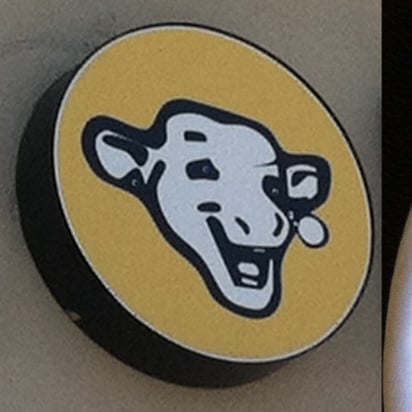
I though this was the “Mildly terrifying” forum for a sec.
I will never ever ever be impressed by this shit. All I see is a very stupid person taking an unnecessary risk for clout.
Rope or not this is terrifying! It’s a no from me
This is a lot less impressive when you rotate the image to the right.
I dunno, that background tho. Becomes something out of scifi.
Why?
More pixels:

Rope and anchor much easier to see here.
I’m actually glad for that. I thought he was free climbing and it made me nervous.
He is free climbing. He’s not using things like a ladder to climb.
He’s not free soloing, which is done without a rope.
There’s also rope soloing where you use a rope but you don’t have a belayer and have to catch yourself on falls.
I think the only climber that did it free solo is Alex Honnold. He took a less deadly route I believe. The documentation is fear inducing though.
Thank Jebus he has a rope. Original picture made me feel bad and nervous.
I’m so pleased to discover he’s smart
“smart” being a relative term here…
Yeah, one of the best climbers in the world is not ‘smart’ when climbing with the proper security setup.
one of the “best climbers” just means “hasn’t yet had a catastrophe”. even ‘with precautions’ one mistake and it’d hurt like hell getting smacked and scraped against the front of that rock face, while flailing and trying to control the situation, recover…
its kinda like jumping out of a plane with a parachute. yeah sure ‘precautions’ but you’re still deciding ‘yes I should leave a perfectly capable vehicle to plunge towards the earth with comparatively minimal control over the situation’. and in both situations, your safety gear isn’t guaranteed…
so yes, very “smart” indeed
Yeah. Rope and anchor mean that falling isn’t guaranteed death. I still wish he’d have a helmet, though.
Yeah, my thoughts go more towards a slip and fall and smashing into the side of the mountain rather than a slip and fall to the bottom.
I trust the rope and anchors to keep his body in the air.
He apparently trusts his body to do the rest.
On less than vertical terrain like this, you don’t smash into the wall so much as skid down it. On easier routes, this can be more dangerous, since there can be more ledges to hit. But on this route, there are very few features on the wall at all, so the danger is small. Also, with pro so close, total fall distance would be minimal, further decreasing the odds of hitting something.
On steeper terrain, falls are even safer - assuming you are given a proper belay. With a good belay, you simply fall into empty space with nothing at all to hit. But with an inexperienced and nervous belayer, they might take in slack when you are falling, which is bad, since it turns the rope into a pendulum, resulting in you “spiking” the wall with significant force. Another danger is getting your foot tangled up in front of the lead line, causing the rope to flip you upside down when it comes taught, which has a significant chance of putting your head where you don’t want it to be.
Adam Ondra has been climbing since he was a kid and has likely taken many thousands of lead falls over the years. His belayer is someone with lots of experience who he knows and trusts. If he thinks the helmet is unnecessary, I’m inclined to trust him to make his own judgements about safety.
Usually climbers who do lead climbing have a lot of experience indoors and on safer routes before moving onto ones like “El Capitan”, so their reflexes are properly trained.
Also a lot of the impact is absorbed by the belayer and by your feet. The way your center of mass is situated and the fact that you’re almost always facing the wall helps guide you feet first. There is a limited distance between the points where you clip in, so the distance isn’t too big.
The only injury I ever got while lead roping* is a strained finger, so its not as dangerous as it seems If you have proper training and user the proper equipment.
Top roping has almost no impact forces. For lead/sport climbing that he’s doing there are quite a bit more forces. But it’s still safe if you handle it correctly and don’t swing too far.
I believe the route might also be partly trad, where you have to place your own safety into the rock itself without the help of bolts.
lead roping*** misstyped :p
You never smash into the wall while climbing like this. The elasticity od the rope is enough for the fall to he easy to catch with your feet.
Every single manner of objectively rating or quantifying intelligence has disappointed me
When I first looked at the OP I thought someone had photoshopped out the rope and quick draw and was mad at them. Then I looked more closely and saw that it was just shitty quality and they blended in really well.
I still couldn’t see it, till I realised it’s underneath, not above, the climber!
Ah, thank you
But still 😵💫
Fyi Adam is free climbing here but not free soloing; there’s a big difference. The rope in this photo has either been edited out or is hard to see. Free climbing means climbing without aid, like ladders or ascenders attached to the rope. If youve climed at your local gym, you have free climed.
Edit: it’s just hard to see but it’s there. It’s yellow and coming down beneath him.
Yeah what we see here is called “trad climbing” and specifically it seems like he’s lead climbing here (first one up and putting in the rope as he goes along).
Adam is a fucking beast btw for those that don’t know him he’s one of the best in the world.
Nah; it’s actually sport climbing, not trad. You can see in the higher definition photo that he’s got a quick draw attached to a bolt below him. Trad (traditional) climbing means climbing without prebolted routes where you place pro(tection) as you climb, like cams, nuts and hexes to name a few. If he were climbing trad, you would see a bunch of pro hanging off his belt because he’d need to place it as he climbs. Also pretty sure there’s not even enough going on on the dawn wall to climb trad which is why it’s generally looked down upon to bolt a wall if pro can be placed. Trad climbing the same wall would be much harder than sport climbing the same wall because placing pro is so more more involved than placing a quickdraw. Also you have to carry it up. Also if you place pro incorrectly and you fall you can die. Sport climbing in practice is much safer.
To clarify further, the quickdraws are already placed for him. This is likely because the dawn wall is just that hard that you really don’t have a chance if you have to spend the energy placing quickdraws as you climb.
But the route is The Dawn Wall which is a trad route with some bolts.
Oooooh right you’re right trad is placing the anchors etc yourself, I’m still learning. So is this still lead climbing (while being sport climbing) since he’s going up with the rope?
Yes, lead climbing applies to both trad and sport climbing, as long as you climb above the last bolt/piece of protection to clip the rope to the next one.
Thanks for explaining it in a way that a noob like me could understand. So the wall has prebolted routes? Does that mean someone with a drill climbed the wall trad and attached them or how the heck is this done?
Usually when you bolt a route like this (routes that are impossible or near-impossible to trad-climb) you’ll go up some other route and rappel down while placing the bolts. Especially when the bolts are hand-drilled, because that requires both hands.
That makes sense. Thanks for clearing that up
In Yosemite it is illegal to use power tools so all those bolts were drilled by hand by hitting a masonry drill bit with a hammer and twisting.
Does anyone know of any active climbing community on Lemmy?
Not very active, but [email protected] sees some posts every now and then. Only way to make it more active is to join :)

If that scares you, do not look up Alex Honnold freeclimbing yosemite several times now. And he’s taken some gnarly routes.
“Good morning, Captain.”

Beat me to it by one minute, goddamnit!
A what point does it change from unique hobby to death wish?
It’s hard to see from the shrunken picture, but he has a rope to catch him if he falls. The likelihood of an injury is very low.
A what point does it change from unique hobby to death wish?
100% when you remove the safety gear.
The mountain, you see, is in nature; and Nature doesn’t give a fuck about your inability to fly once you pop off that flake.
When they go from this to free solo. Especially on such a hard route.
https://brainasap.com/adrenaline-addiction-rock-climbers-thrill-seeking-behavior/
I’m all for letting people have the hobbies they want, but adrenaline junkies are literally wired differently. Kind of weird that they get put on a pedestal for being the “right” kind of neurodivergent.
I don’t think any of the climbers I know would call it an adrenaline sport. It’s slow, considered, thoughtful. It certainly gets a high sometimes, pun intended, but it’s much more akin to a runners high or the elation of finishing a difficult task well.
Halfway through reading this I realized I’m addicted to mountain biking lmao
Better than than cigs, if nothing else
Skiing here, I’d jump off some stupid stuff if I could afford to get there.
When you stop caring about safety.
When the likelihood of death is knowingly greater than the safety precautions taken to avoid death.
I watched a video about a person with a rare condition that makes him not have a fear response and now, everytime I see people doing stupid shit like this, I think “bet it’s not so fucking rare”
Don’t be do quick to judge: He’s secured by a rope that passes through a series of bolts that are drilled into solid granite. You could lift a car with the gear he’s using to secure himself.
You’re less in control of your fate when passing someone on the highway than he is here. The only way he dies in this situation is first slipping off (first layer of protection is your hands and feet), and then having several layers of ridiculously redundant protection fail.
Belaying a lead climber is much less straightforward than belaying a top roper, so that’s all true assuming he has an excellent belayer, which I’m sure Adam does. That being said mistakes still happen; just look at Sara Al Qunaibet’s recentish fall. Alex Honnold was also dropped by his (at the time) girlfriend and suffered injury. He was lucky to be on the first pitch of a multi pitch climb at the time.
It’s absolutely true that human error can occur, and it does happen sometimes. Of course, nobody is doing big-wall climbing with a grigri (although in Sara Al Qunaibets case there was even a grigri that the coach was able to misuse…). I still feel safer taking a fall with a belayer I trust than I do driving behind some stranger that’s driving erratically. The most dangerous part of any climb on pre-bolted route is likely the drive to the crag.
Totally agree. Feeding through a Grigri in order to lead belay necessitates disabling the autolockimg behavior of the device and creates an opportunity for a fall to the ground if the climber loses it unexpectedly. Belaying with an ATC still isn’t a replacement for vigilance, though. Catching a lead fall with minimal fall distance requires a combination of constant attention, deep understanding of the route, its cruxes, and your climber, anticipation of the fall based on your observation of the climber, and bulletproof mechanical memory of the process. Even still, runout is a thing on many routes. I would add on to your statement; the most dangerous part may be the drive to the crag (or perhaps, a scramble approach) but the second most dangerous part may well be the climb to the first draw.
I agree with you on the by and large, but wouldn’t describe belaying a lead climber as quite as demanding as you do (by all means, be vigilant at all times, someone’s life is in your hands!). You can feed out rope from a grigri without putting a thumb in the mechanism, but it’s a bit more of a hassle, and requires a bit more getting used to. I’m pretty much always belayed by my SO (who’s a much better belayer than me, and doesn’t disable the grigri when feeding) and get stressed out if someone else is belaying me and I notice that they’re disabling the grigri while feeding rope.
It’s definitely true that by far most injuries in climbing occur on the first 1-3 bolts, when it’s still possible to hit the ground if you have too much slack or a bit run out bolts. Long run outs higher up can feel sketchy, but even a >5m fall high in the wall isn’t really dangerous unless there are outcroppings or other stuff you can hit. Ankles might still take a beating though…
I understand, hey go climb a big rock. cool.
i don’t understand doing it without a basic life line attached to you to …ya know, prevent … rapid inertia.
Is the rope hanging off him not a life line?
I see no rope.Better picture given in another post shows a fall rope plain as day.
Yellow line from his butt.
I’d also have a yellow line coming from my butt in this scenario.
Someone else posted a better pic, definitely looks like a fall rope tied to something. The OP Pic is potatoes and you can only discern a line that could be natural crack.
Honestly, I’m not sure. I actually didn’t even notice it until you said something. It blends in very well. Looks like it only goes below him but I don’t see an anchor point and you really don’t want them too far apart. The more distance between them, then more force it’s got to hold if you fall.
I’m not sure what else you’d use a rope for here. Just saying it’s also weird to not see an anchor point since it looks looks to be over 10ft of rope we can see.
He’s barely above the last bolt in the picture. There’s a quickdraw sticking out by his lower heel.
Also the forces involved in a climbing fall are partly mitigated by the stretch of the rope, and the belayer will soften the catch by jumping as the climber falls. The length of a fall has little impact on the forces experienced by the climber or the gear in a typical climbing fall.
There’s an anchor right below his feet but it’s hard to make out in this copy of the photo because of the lack of pixels.
Either way I still think he’s crazy, I couldn’t get 10 feet off the ground without having a panic attack.
Multi story buildings must be your kryptonite.
This is a normal human reaction.
But then you do it a few times and you get used to it.
I’m not sure what else you’d use a rope for here.
My guess is it’s a tow line for something. Notice how the rope is taught (would not be the case if it were an anchor, he’d have to ditch the anchor and use a new one if that were the case)
Though again it would be weird to have whatever you’re “towing” that far below you, considering the longer the rope, the stronger the pendulum when wind starts to blow your gear around…
Look up thread. Better pic posted shows it is clearly his lead line, and he has a bolt at his feet. The rope looks tight because it has friction from running through the pieces below, and because the rope has weight of its own pulling it down.
According to the article it was free solo.
The article is wrong. You can clearly see Adams lead line in the picture in the article.
Adam on The Dawn Wall was super impressive - iirc, he sent the route in a single ground-up push or something like that, when it took Tommy, like, 8 years to establish the route. But he def didn’t solo it.
Source: rock climber for 10 years, going to climb in The Valley later this week.
This is wrong, he free climbed the dawn wall but definitely did not free solo it. Every photo from that article shows him climbing with ropes and google more into it he definitely didn’t free solo that face of El Cap.
Unwavering
Great pic.
Fuck that.
These freesolo guys are crazy impressive.
Is he wearing jeans?
Is that not a rope right under his butt?
Yep I missed that.
Yeah, it’s there, just hard to see
The wall after you finally got that mosquito












